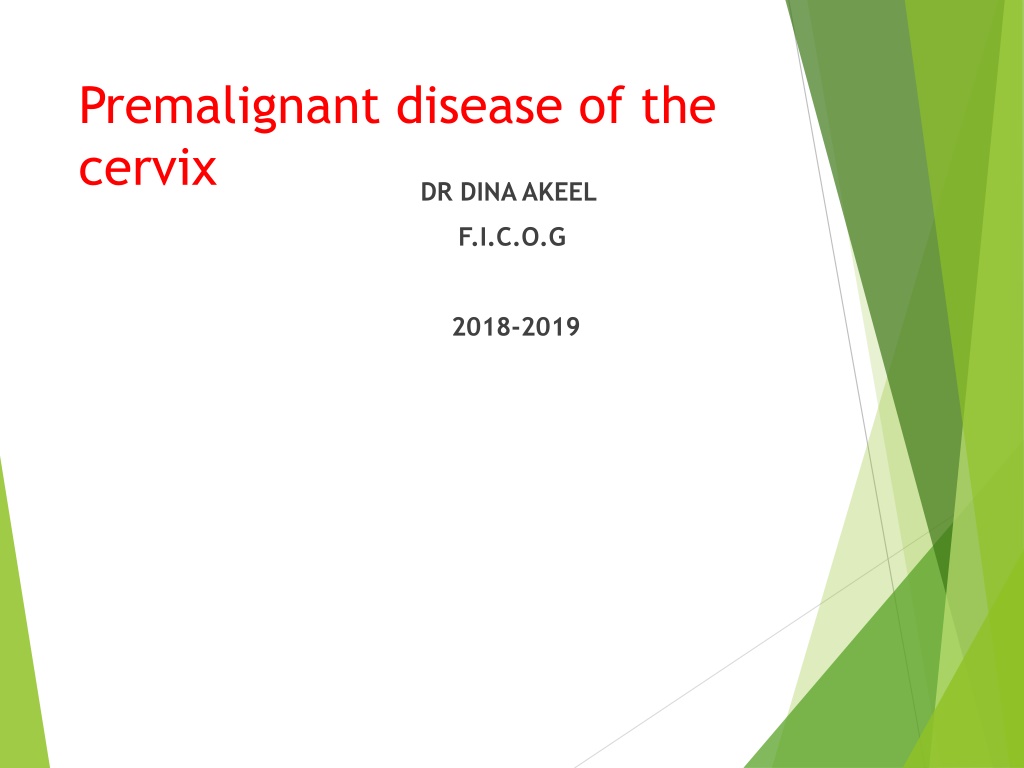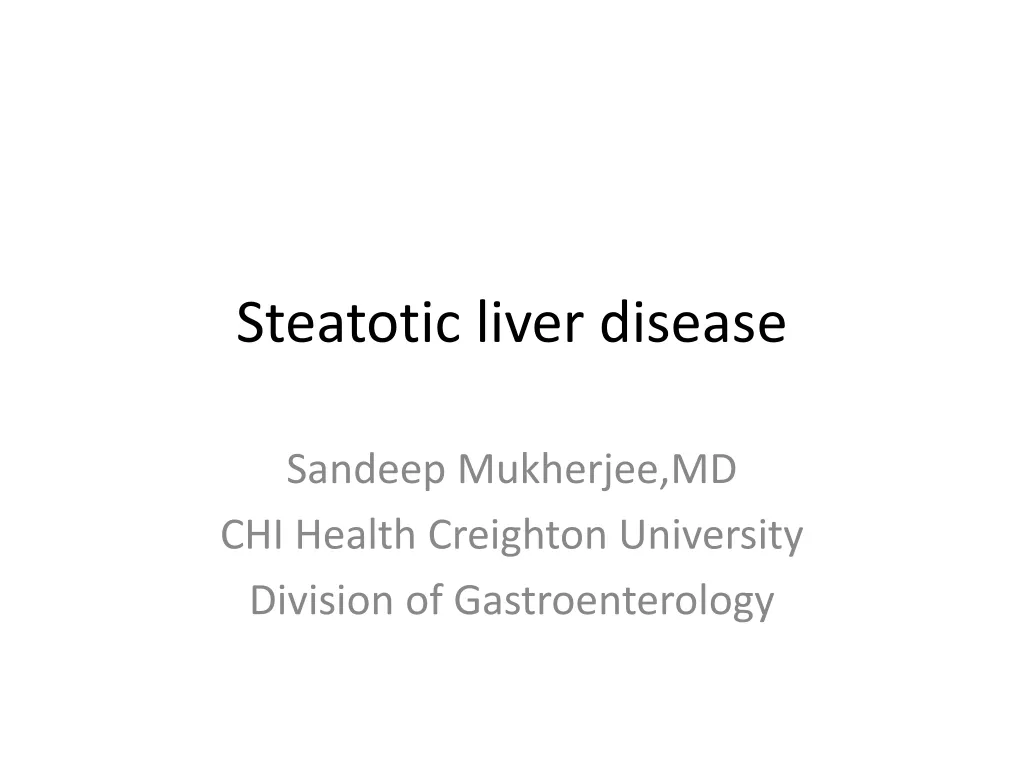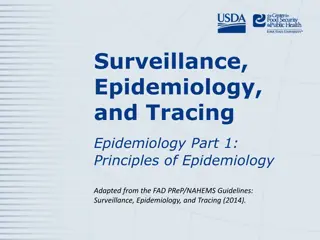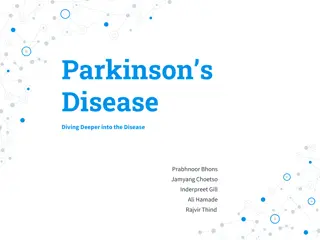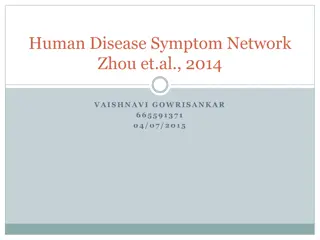Premalignant Disease of the Cervix
Premalignant disease of the cervix is a significant health concern, particularly in developing countries. Carcinoma of the cervix ranks as the second most common cancer among women globally, with preventive measures vital for early detection and treatment. This article discusses the pathophysiology of the cervix, including the transition from columnar to squamous epithelium and the importance of the transformation zone. By understanding the risk factors and progression of premalignant cervical disease, efforts can be focused on prevention and intervention strategies.
Download Presentation

Please find below an Image/Link to download the presentation.
The content on the website is provided AS IS for your information and personal use only. It may not be sold, licensed, or shared on other websites without obtaining consent from the author.If you encounter any issues during the download, it is possible that the publisher has removed the file from their server.
You are allowed to download the files provided on this website for personal or commercial use, subject to the condition that they are used lawfully. All files are the property of their respective owners.
The content on the website is provided AS IS for your information and personal use only. It may not be sold, licensed, or shared on other websites without obtaining consent from the author.
E N D
Presentation Transcript
Premalignant disease of the cervix DR DINA AKEEL F.I.C.O.G 2018-2019
Premalignant disease of the cervix Carcinoma of the cervix is a common killer of women in the reproductive age group. The main burden of cervical cancer is in the developing world. while In the developed world, the picture is vastly different where cervical cancer is uncommon cancer thanks to screening, education and access to good medical care an
Carcinoma of the cervix is the second commonest cancer among women worldwide, with only breast cancer occurring more commonly
While the natural history of breast cancer is poorly understood, cervical cancer is a preventable condition and considerable effort goes into detecting and treating the pre invasive disease.
Pathophysiology The cervix is a tubular structure between the uterus and vagina
Epithelium of the cervix: The ectocervix is covered by squamous epithelium .The canal of the cervix, however, is lined by columnar epithelium, and the point where these two epithelia meet is called the squamocolumnar junction (SCj)
Squamous metaplasia The cervical canal is lined by columnar epithelium, this epithelial exposed to the acid environment of the vagina under goes a process of metaplasia where by it becomes squamous epithelial.
The transformation zone TZ is an important area on the cervix which is defined as the area where the original SCJ was to the current SCJ and it includes areas of Normal cervix with transformation zone
The transformation zone (TZ) is the site where premalignancy and malignancy develop
Dysplasia: The process of the metaplasia can be disrupted by external influences and lead to disordered squamous epithelial called dysplastic epithelial
Squamous metaplasia should not be diagnosed as dysplasia (or CIN) because it does not progress to invasive cancer.
HPV is now implicated in this process. Approximately 99-100 % of intraepithelial neoplasia is attributed to human papillomavirus (HPV) infection is a common sexually transmitted infection (STI) Smoking and immune suppression appear to be additional factors which may act as co- agent.
(CIN). These dysplasia now termed cervical intra epithelial neoplasiaCIN which has the potential to turn malignant without treatment
(CIN). CIN I (mild dysplasia).: affected only the deepest third of the epithelium from the basal layer upward, with maturation seen more superficial to that CIN II (moderate dysplasia): affected the second third of the thickness of the epithelium. CIN III (severe dysplasia, carcinoma in situation). show no maturation throughout the full thickness
Cervical intraepithelial neoplasia grade 1 with koilocytosis
Cervical intraepithelial neoplasia grade 3.
Bethesda classification In North America and many other countries, the Bethesda reporting system has been adopted. The classification uses the term squamous intraepithelial lesion (SIL) to encompass all grades of CIN. SIL is further subdivided into two categories :
Bethesda classification (LSIL) low grade which includes cellular changes associated with human papilloma virus (HPV) infection and CIN 1. low progressive potential (HSIL) high-grade SIL which includes CIN 2 and 3. are likely to behave as cancer precursors
All CIN are reversible lesions (i.e. curable lesions) and directed more to malignancy with increase the degree of dysplasia.
High-grade disease is less likely to regress spontaneously and requires treatment as there is a risk of progression to cancer
Diagnosis of preinvasive disease. 1.Cytology 2.Histology. 3.Colposcopy
(Pap smear): Cytology cervical smear: (Pap smear):it is a screening test of apparently healthy woman& symptoms free for the purpose of detection of pre-invasive disease of the cervix which if treated can prevent the occurrence of invasive cervical cancer..
(left slide ) Conventional cervical cytology is prepared by smearing collected cells directly onto a glass slide with the collection device followed by immediate fixation (right slide ) Thin-layer liquid- based cytology involves transfer of collected cells from collection device into a liquid transport medium with subsequent processing and transfer onto a glass slide. Cells debris, mucus, blood, and cell overlap are largely eliminated
WHAT TYPE OF TEST IS USED The NHS screening program now uses liquid based cytology (LBC) for screening.
Liquid-based cytology normal cytology.
Liquid-based cytology severe dyskaryosis
What do you know about cervical cancer screening?
Screening Guidelines Who to screen(Any woman with a cervix who has ever had sexual intercourse)
AGE TO BEGIN SCREENING The American Congress of Obstetricians and Gynecologists currently recommends that cervical cytology screening begins at age 21 years, regardless of sexual activity or other risk factors.
Cervical cancer is extremely rare in women younger than age 21 (1 case per million), and screening adolescents has not been successful in preventing these rare cancers
In addition, adolescents have higher incidence of HPV- related dysplasia because the cervix is immature, but most of these lesions resolve without treatment, so screening in this population may lead to unnecessary and potentially harmful treatment.
How frequent? women 21-29 years should be screened every 3years,they should not be tested for HPV unless it is needed after an abnormal Pap smear .
How frequent? Women 30-65 years of age should be screened with both cytology (using the conventional Pap or liquid-based method) combined with HPV testing every 5 years (preferred) or with cytology alone every 3years (acceptable). screening can stop at age 70 if there has been no abnormal Pap test result in the past 10 years
When to stop routine screening Age 65 and adequate recent screening Three consecutive normal pap smears No abnormal pap smears in last 10 years No history of DES exposure No history of cervical or uterine cancer
When to stop routine screening Hysterectomy for benign disease USPSTF recommends discontinuation Hysterectomy for invasive cervical cancer ACOG and ACS recommend continued screening
Colposcopy: A colposcope is a microscope with magnification of 5-20 times, by which would be able to recognize the earliest lesions of the cervix that were invisible to the naked eye.
Solutions 1.Normal Saline Saline helps remove cervical mucus and allows vascular and surface features of lesions to be initially assessed. 2.Acetic Acid .Also known as white table vinegar. 3.Lugol Solution
Schiller iodine test A test used to identify normal squamous epithelium which contains glycogen that stains dark brown with iodine, after application of lugol iodine solution. While abnormal squamous cells (lack of glycogen) fail to stain and appear bright in colour which is the site for biopsy (colposcopic directed biopsy).
The use of 3-5% acetic acid to visualize the abnormal epithelium show the CIN as white area compared with pink normal squamous epithelium
LSIL. Seen after 5-percent acetic acid application, lesions are often multifocal and bright white with irregular borders
abnormal colposcopic finding Acetowhite epithelium. Punctation (dilated elongated vessels). Mosaic (crazy paving appearance). Abnormal blood vessels (coma shape, wires) in invasive cancer.
Punctation (dilated elongated vessels).
